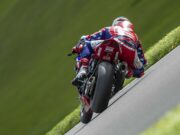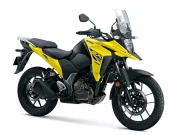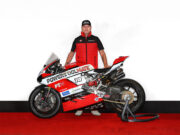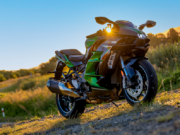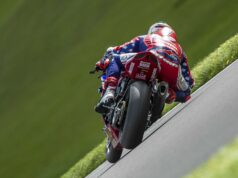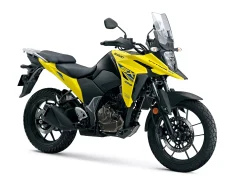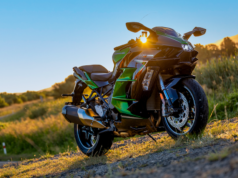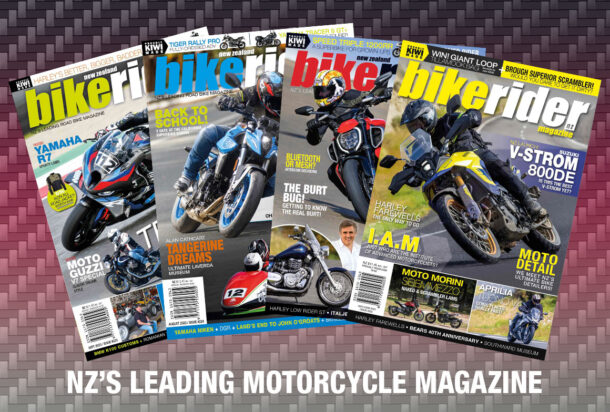Words: Roland Brown Pics: Milagro (Cervetti/Zamponi)
With the U.S.A an untapped market for Moto Guzzi, a bike designed Stateside that ticks all the ‘bagger’ boxes is the first step for the Italian brand to gain traction Stateside
There’s a good reason why this new model in Moto Guzzi’s California family is the MGX-21 Flying Fortress – a “bagger” with an American name, batwing fairing, gigantic 21-inch diameter front wheel, and a blend of carbon-fibre bodywork and red highlights that help make it one of the most visually striking cruisers of recent years.
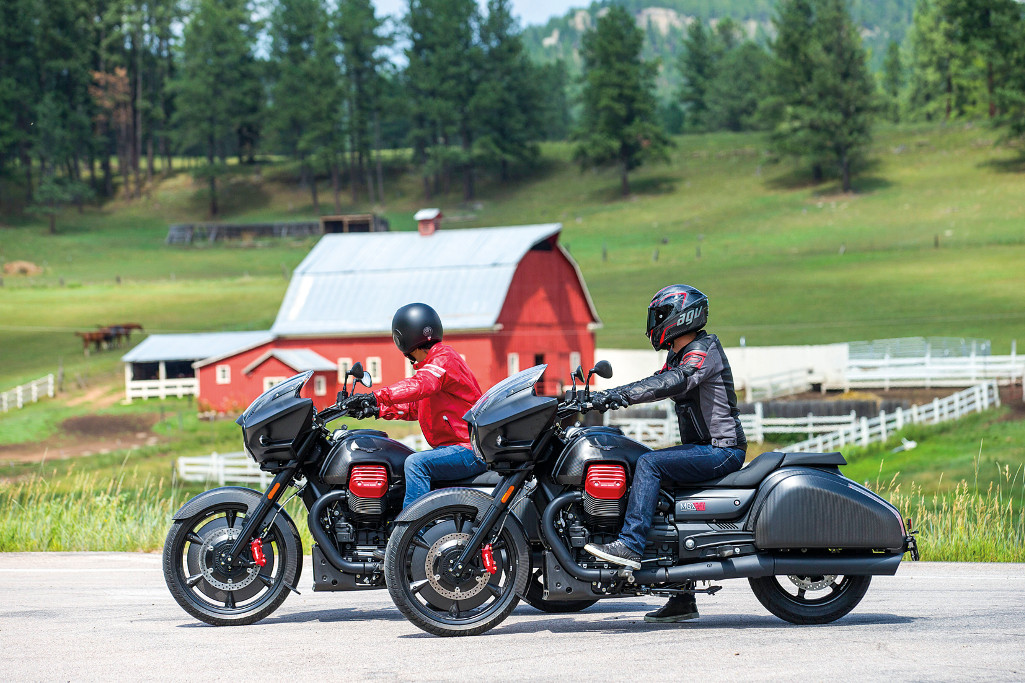 Guzzi is desperate to make an impression in the American market, where you might think Italy’s oldest bike firm would be pretty successful, given the Stateside popularity of big, aircooled V-twins with a heritage theme. On the contrary, Italy’s oldest bike firm is so little known across the Atlantic, even among owners of American V-twins, that US sales accounted for less than ten per cent of last year’s modest total of 8000 sales.
Guzzi is desperate to make an impression in the American market, where you might think Italy’s oldest bike firm would be pretty successful, given the Stateside popularity of big, aircooled V-twins with a heritage theme. On the contrary, Italy’s oldest bike firm is so little known across the Atlantic, even among owners of American V-twins, that US sales accounted for less than ten per cent of last year’s modest total of 8000 sales.
The MGX-21 has been created primarily in an attempt to boost Guzzi’s presence and profile, especially in the States. Like the now four-year-old California and its Eldorado and Audace spin-offs, it was designed in Pasadena, California, at the Piaggio design studio headed by Miguel Galluzzi. Guzzi say the X in its name stands for eXperimental, and that the 21 refers not only to the front wheel diameter but to 1921, the marque’s first year of production.
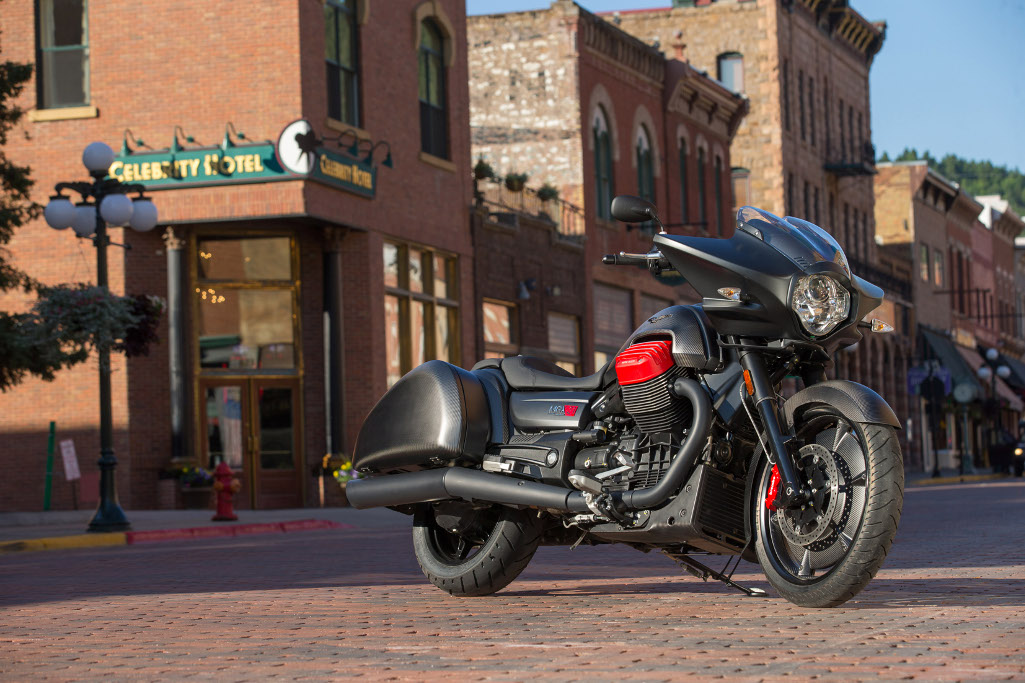 The MGX seemed pretty experimental when the radical bagger was unveiled as a concept at the EICMA show in Milan in 2014. Almost two years later it’s entering production looking almost identical, following positive feedback at US customer clinics. Further American influence is clear in the Flying Fortress name, inspired by Boeing’s B-17 bomber from World War II.
The MGX seemed pretty experimental when the radical bagger was unveiled as a concept at the EICMA show in Milan in 2014. Almost two years later it’s entering production looking almost identical, following positive feedback at US customer clinics. Further American influence is clear in the Flying Fortress name, inspired by Boeing’s B-17 bomber from World War II.
It’s a striking bike, featuring carbon on its tank and pannier covers, front mudguard and belly-pan, as well as the centre of that big front wheel. The sharp-edged fairing holds an LED front light. Splashes or red on the Brembo front brake calipers and cylinder heads add contrast to a bike that is otherwise mostly black.
Despite those “Testa rossa” heads, the 90-degree V-twin lump has the same level of tune as the other California-based models, so kicks out a maximum of 96bhp at 6500rpm. It also follows the others in having three riding modes, labelled Veloce, Turismo and Pioggia (Fast, Touring and Rain) and a three-way adjustable traction control system.
The California’s method of rubber-mounting the motor is also retained but the chassis is beefed up, with the tubular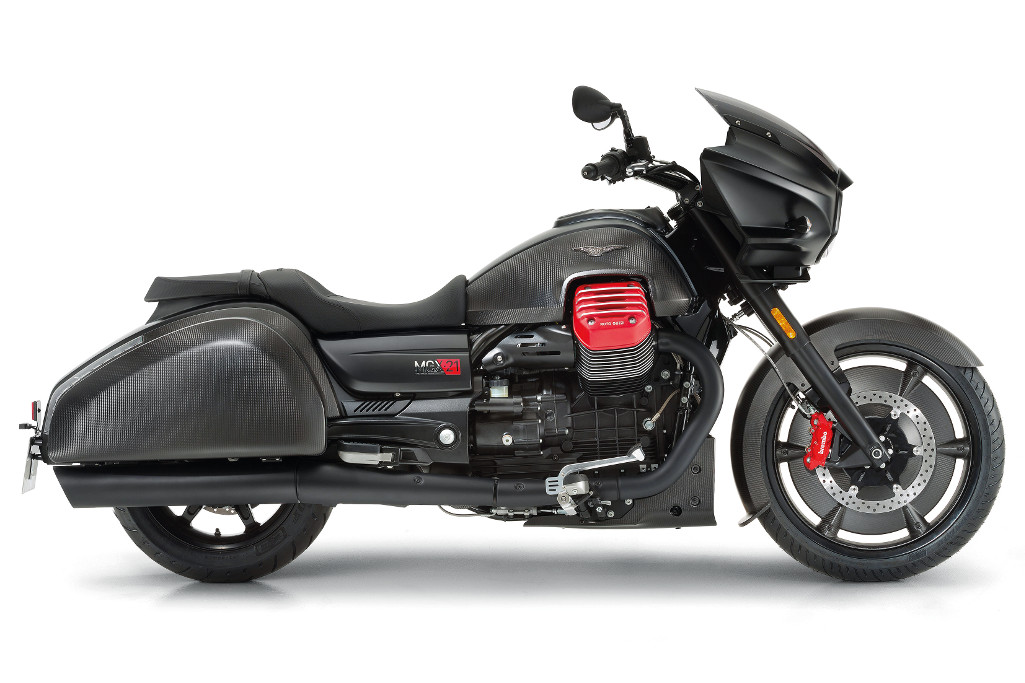
steel frame being strengthened for increased rigidity with thicker front tubes and a reinforced rear section. Up front, the 45mm forks are kicked out at a lazy 32 degrees and give just 107mm of wheel travel. Behind the panniers are twin shocks with remotely adjustable preload and a relatively generous 120mm of travel.
Ready For Takeoff
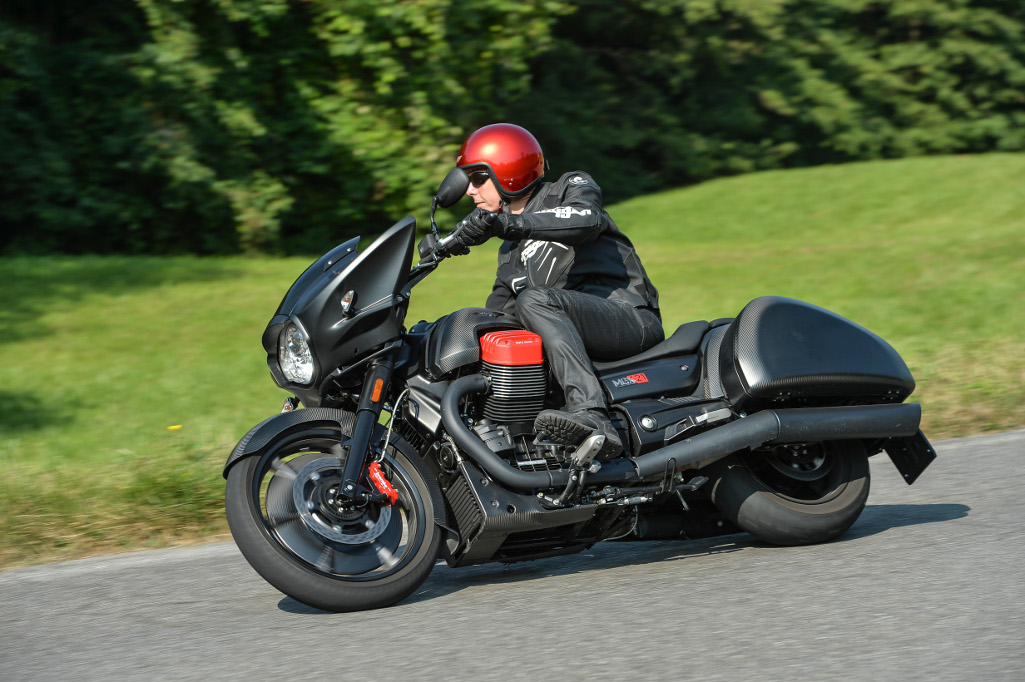 Lined up outside a Milanese hotel for its European debut, the Flying Fortress looked like no other Guzzi, but much about it was familiar. The bars are wide and pulled back. The transverse V-twin motor came to life with that age-old rock to the right as I blipped the throttle. It jiggled around in the frame at idle, and chuffed in familiar fashion through the black-finished pipes.
Lined up outside a Milanese hotel for its European debut, the Flying Fortress looked like no other Guzzi, but much about it was familiar. The bars are wide and pulled back. The transverse V-twin motor came to life with that age-old rock to the right as I blipped the throttle. It jiggled around in the frame at idle, and chuffed in familiar fashion through the black-finished pipes.
That abundance of low-rev torque sent the MGX pulling forward effortlessly when I let out its light-action clutch, the sweet ride-by-wire throttle response helping make it responsive but not remotely snatchy, even in the slightly sharper Veloce mode. (There’s little difference between the main two modes.) The softly tuned V-twin generates a hefty maximum of 121N.m of torque at just 3000rpm, and the near-flat curve contributed to its laid-back character.
The Fortress was happy to cover ground quickly when required, although for maximum acceleration I had to use the revs but make sure to change up before the rev-limiter cut in at around 7000rpm. The twin, circular clocks are stylish but I found them slightly hard to read, especially in bright sunlight. Generally, it was best to short-shift through the fairly sweet six-speed box and enjoy the bike’s ability to sit smoothly at 125km/h or more in typically long-legged Guzzi fashion.
The MGX should also live up to its heritage by being able to cover serious distance. The tank’s fairly generous 20.5-litre capacity should give most riders a range of 300km. I found the stepped seat fairly comfortable too, though the pillion doesn’t get as much room. The panniers are useful large and easy to open, and come with inner bags, but aren’t big enough for a crash helmet.
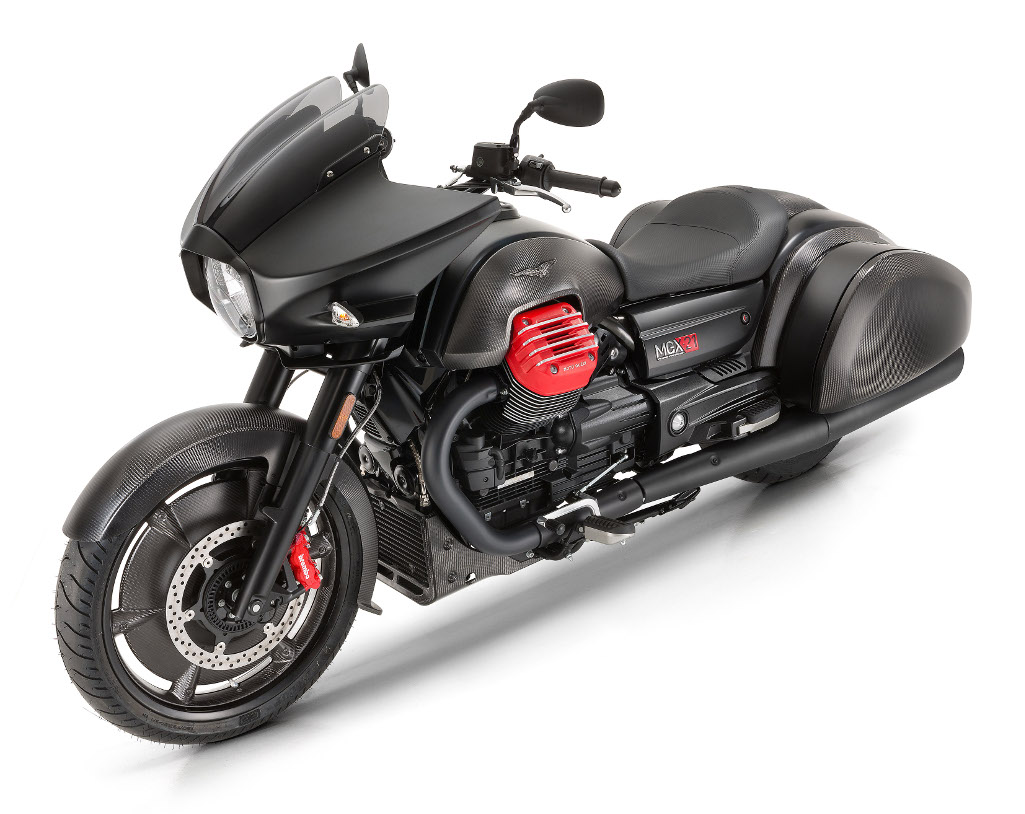 On the launch route from Milan to Guzzi’s Mandello base and back, the Fortress chassis’ performance was mixed. That big, carbon-covered front wheel is seriously heavy (Guzzi wouldn’t say how much heavier than the other Cali models’ smaller wheels it is), and tends to make the bars flop into slow turns. So the firm has developed a special steering damper that it calls a “manoeuvring assistance system”, which gives increased resistance as the bars approach full lock.
On the launch route from Milan to Guzzi’s Mandello base and back, the Fortress chassis’ performance was mixed. That big, carbon-covered front wheel is seriously heavy (Guzzi wouldn’t say how much heavier than the other Cali models’ smaller wheels it is), and tends to make the bars flop into slow turns. So the firm has developed a special steering damper that it calls a “manoeuvring assistance system”, which gives increased resistance as the bars approach full lock.
This presumably helps, but it can’t prevent the MGX feeling distinctly unwieldy at low speeds, even by the standards of other big cruisers. Perhaps it’s because the damper doesn’t cut in until the bars have turned by ten degrees in either direction, but the non-linear resistance seemed to make the bike harder to balance, for example when making a U-turn. Or perhaps it’s the huge amount of trail; at 187mm, more than 40mm up on the Audace and Eldorado. Shorter riders, in particular, found the bike hard work in traffic. And adding a pillion would make it even more demanding.
At least the seat is pretty low, at 740mm, so allows most riders to get both feet down when stationary. And at higher speeds the handling was much better. In medium speed turns the Guzzi felt very composed for a shaft-drive cruiser that weighs over 340kg without fuel. It seemed to shed most of that weight on the move, and was reasonably easy to aim into bends with a nudge of the wide handlebars.
Presumably the stiffer frame contributed to the bike’s stability, and its suspension also worked well, combining a fairly plush ride with sufficient damping for reasonably enthusiastic cornering. Ground clearance was good by cruiser standards, as you’d expect of a Guzzi, and the Dunlop Elite tyres were well up to the job. So too were the brakes, with those radial four-pot front Brembo calipers biting hard, and the single rear disc adding some useful force at times, along with a well sorted ABS system.
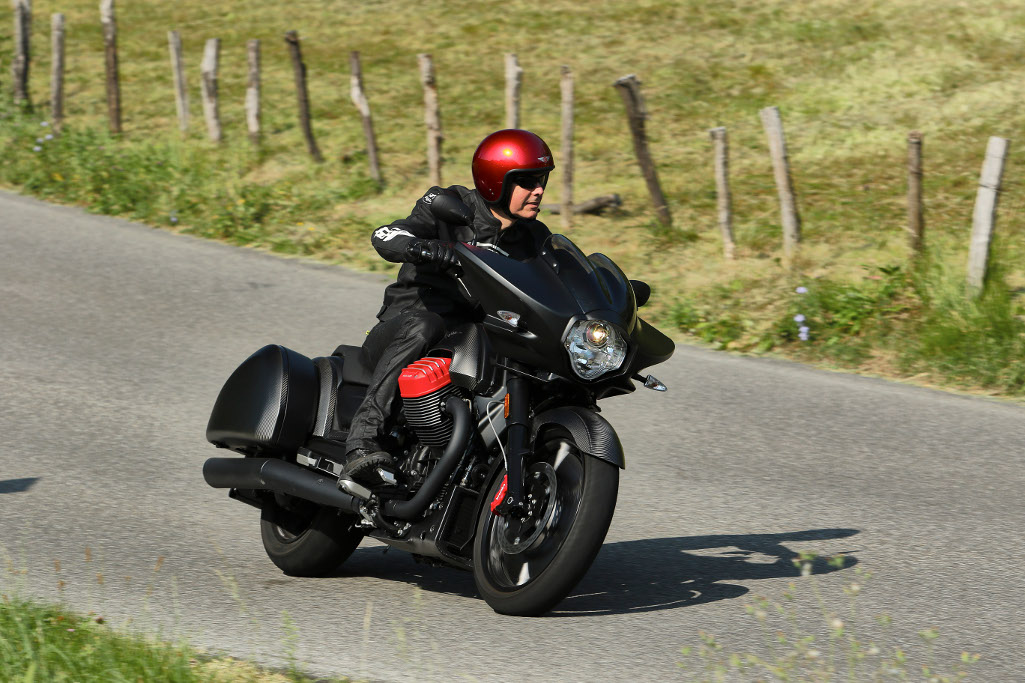 The twisty launch route meant I didn’t have much need of the MGX’s standard fitment cruise control. I was still grateful for the protection from the fairing, which shields hands well. But at much above town speeds its screen generated enough wind turbulence to drown out the standard fitment sound system – a bagger essential – despite its 50W per channel output. That is a common failing of baggers, with their typically low screens, but annoying all the same.
The twisty launch route meant I didn’t have much need of the MGX’s standard fitment cruise control. I was still grateful for the protection from the fairing, which shields hands well. But at much above town speeds its screen generated enough wind turbulence to drown out the standard fitment sound system – a bagger essential – despite its 50W per channel output. That is a common failing of baggers, with their typically low screens, but annoying all the same.
The Fortress’s sound system was clever enough to pair easily with my phone’s Bluetooth, and incorporates Guzzi’s Media Platform which allows a smartphone app to display and record various aspects of the ride. There’s also a handy USB socket below the instruments, although you’ll need an accessory to hold a phone because the bike has nowhere to store it. Talking of accessories, there’s a predictably large number, including a taller screen, numerous billet aluminium and extra carbon-fibre parts, comfort seats, leather luggage and California style footboards to replace the standard footrests.
Even in standard form the MGX-21 is expensive, costing roughly 15 per cent more than the identically powered Audace, which many riders would find easier to get on with. But the Flying Fortress has the fairing, the sound system, the bags, and most of all the radical, carbon-clad look. It also has exclusivity on its side, because it is being produced in relatively small numbers, and sold only in a handful of Guzzi dealers in each main market.
If you like the MGX’s radical look you’d probably enjoy riding it too, although the feel of that front wheel won’t be to everyone’s taste. Either way, the big, bold bagger looks like giving Moto Guzzi’s profile a useful boost, especially in the US, as the old firm heads towards its 100th anniversary in 2021.
Moto Guzzi MGX-21 Flying Fortress Specifications
Price: $TBC – only limited numbers coming to NZ
Engine type Aircooled 90-degree transverse V-twin
Valve arrangement High cam, four valves per cylinder
Displacement 1380cc
Bore x stroke 104 x 81.2mm
Compression ratio 10.5:1
Fuelling Magneti Marelli fuel-injection with ride-by-wire
Maximum power 96bhp @ 6500rpm
Maximum torque 121N.m @ 3000rpm
Clutch Dry single-disc
Transmission 6-speed, shaft final drive
Front suspension 45mm telescopic, 107mm travel
Rear suspension Twin shocks, 120mm travel, adjustments for preload
Front brake Two four-piston Brembo radial calipers, 320mm discs with ABS
Rear brake Twin-piston Brembo caliper, 282mm disc with ABS
Front tyre 120/70 x 21in Dunlop Elite
Rear tyre 180/60 x 16in Dunlop Elite
Rake/trail 32 degrees/187mm
Wheelbase 1700mm
Seat height 740mm
Fuel capacity 20.5 litres
Kerb weight 341kg (no fuel)



